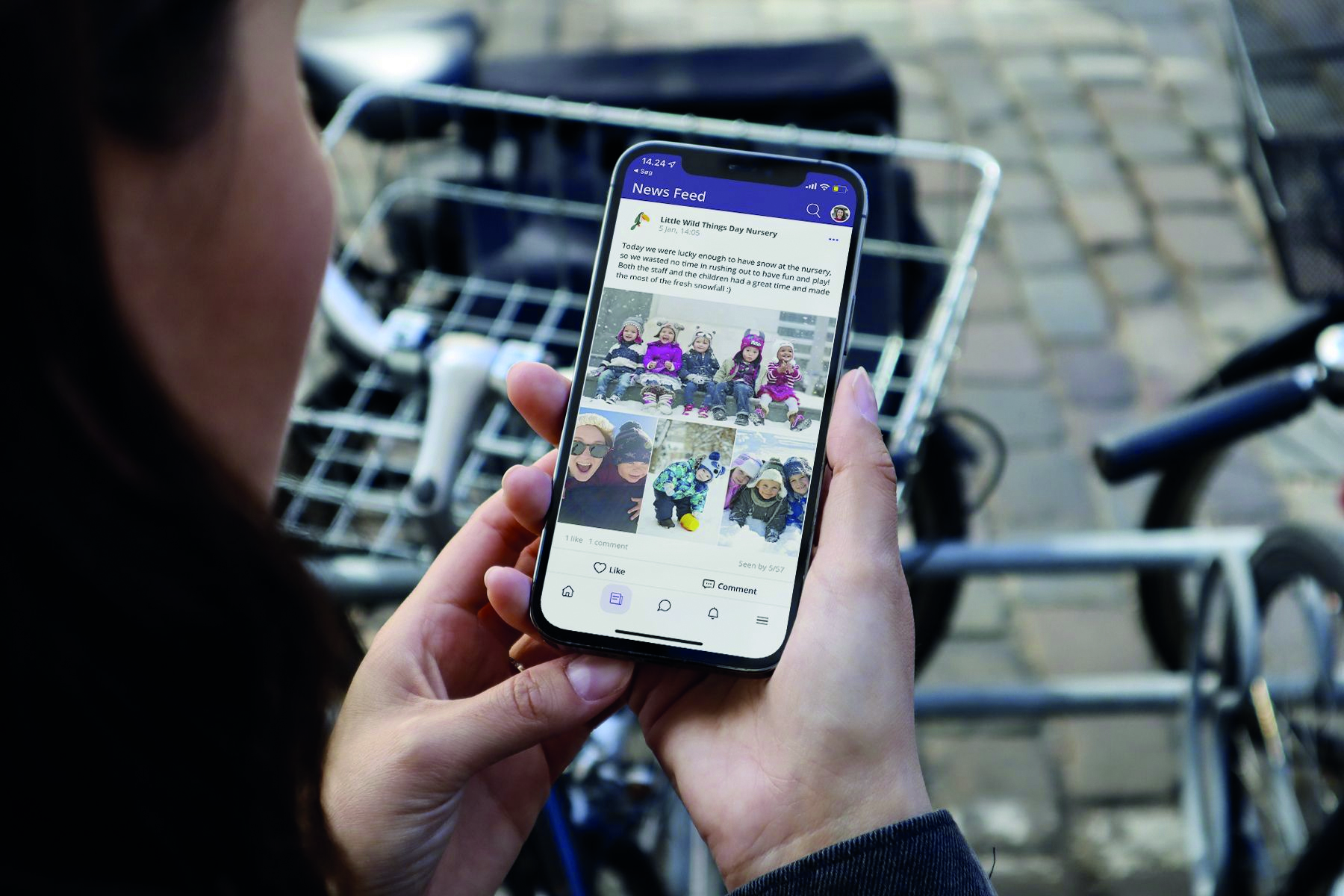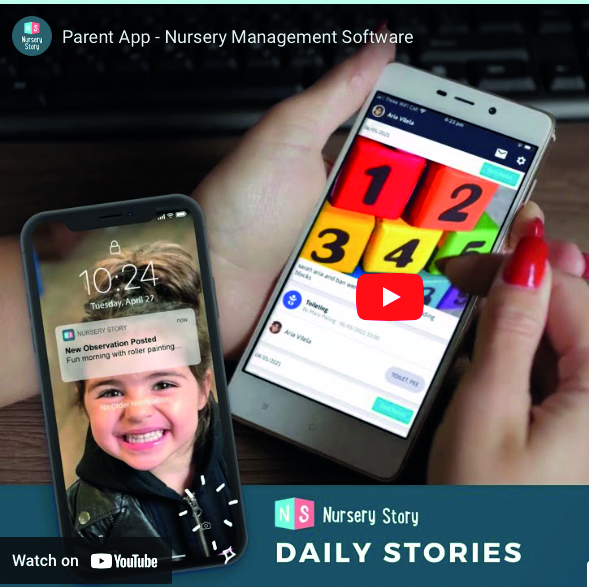
The days of printing out photos, captioning them with hand-written notes and sticking them into a colourful scrapbook that’s been lovingly created as a memento to hand over at the end of a child’s nursery journey is almost a thing of the past.
In this new era of virtual communication, parents receive on-tap information about their children’s progress and development. Everything from a live account of how well they settled after drop-off to daily updates about naps, nappy changes or what greens they ate, and sometimes even a video of them having fun in the home corner.
Parents love to take a sneak peek at these snippets of information that pop onto their news feed from the nursery’s parent app while they are at work. They interact with a ‘like’ or a brief comment, which sets them on the road to a two-way relationship with the setting, where they will soon be sharing what they did at the weekend.
‘Parent apps are facilitating a two-way conversation between parents and settings, fostering greater partnerships, which is ultimately good for children, and cutting down on the endless admin burden on nurseries,’ explains Matt Arnerich, head of learning and development at Famly, which offers an all-in-one digital nursery management solution for settings, parents and staff.
FOSTERING RELATIONSHIPS
There is no doubt that communicating with everyone in the family sphere ‘has to take place digitally now’, explains Arnerich.
‘In order for children to thrive in this new world of collaborative caregiving, it’s not an option to opt out, otherwise you are excluding key people and creating inefficiencies for your staff,’ he highlights.
Early years consultant James Hempsall says that parents ‘want and need’ to communicate in app format and that investing in a system with this application is ‘a necessity’ (see box, overleaf).
Kat Learner at Nursery Story agrees, stating that a parent app should be an ‘essential’ part of the core offering of an early years software platform.
‘It’s hugely reassuring for parents and carers to see what their child is doing in-the-moment, particularly if they’ve left an upset child at nursery that day,’ explains Dr Helen Edwards, co-founder of Tapestry and a former Ofsted inspector.
SOFTWARE SOLUTIONS
 There are various nursery software programmes on the market. Parents whose children attend a setting where Famly is used receive photos and updates about their child’s observations and assessments in the same place as they receive their invoices and general administration.
There are various nursery software programmes on the market. Parents whose children attend a setting where Famly is used receive photos and updates about their child’s observations and assessments in the same place as they receive their invoices and general administration.
‘It was built with messaging and communicating with parents in mind, rather than tagging this on at a later date,’ Arnerich says.
Tapestry, which has been around the longest, has been recording children’s learning and sharing it with parents through its online learning journal since 2012, and it has recently launched the first phase of its full nursery management software roll-out, adding an admin functionality to it which will be provided for no extra cost.
Nursery Story, which launched in 2021, is currently a ‘learning, development and parent tool’ but is looking to build a full management platform in the future. And Blossom’s nursery management software offers a bespoke parent communication, learning and management service.
Other platforms in the market also have parent communication on top of their existing management platforms, or have separate packages.
But one thing they all have in common is that they provide settings with the ability to communicate with parents via an app.
IN THE FAMLY
 When nurseries sign up with Famly, parents and families get a free app that works across all devices. Grandparents, aunts, uncles, carers, educators, managers and teachers can all have access to it, with differing levels of permissions and restrictions.
When nurseries sign up with Famly, parents and families get a free app that works across all devices. Grandparents, aunts, uncles, carers, educators, managers and teachers can all have access to it, with differing levels of permissions and restrictions.
Parents see photos of the child’s day, updates about bringing wellies or coats in, reminders of trips, and ‘wow’ moment observations that typify their child’s learning journey. This all sits alongside invoices, payment reminders, permission requests, and child profile information. Parents also have the opportunity to send observations from home, which further enriches the practitioners’ understanding of the child.
‘If nurseries aren’t using platforms like this, they’re missing a trick,’ Arnerich says. ‘There is endless efficiency in bringing parents in to share the admin workload where they already have the information to hand. And along the way, this brings the parent community closer, which can only benefit the children they are nurturing together.’
Parents are also keen to point out that this form of virtual communication ‘doesn’t stop the chats with the staff’ at pick-up times but allows them to talk about more meaningful issues like behaviour and development.
Although the app is an integral part of the Famly platform, smaller nurseries can sign up for free with the Famly Free platform.
TWO-WAY FEEDBACK
Learning about their children’s interests and development at nursery encourages parents to extend their learning at home. In the same way, practitioners can gain deeper insights into a child’s development at home through the sharing of videos and photos by parents. This can be useful in supporting them to adapt their provision to better meet the needs of the individual child.
‘A visual – photo or video – can be a good way to reduce barriers to engagement for parents or carers that have a first language other than English. Also, some parents may not be able to come to the setting as often as they would like, so the app enables them to stay connected with their child and the educators,’ explains Dr Edwards.
‘Talking about the pictures and video clips in their journal helps develop children’s language skills, builds their self-esteem and supports their developing skills in thinking, reflection and metacognition,’ she adds.
Children can also add their own text, photos and videos through Tapestry’s Child login feature, enabling them to have ‘ownership and agency’ in their learning, Dr Edwards says.
Although parents can access the browser from any device, there is a ‘significant demand’ for new and currently browser-only features to be added to the apps, she adds.
‘The app is a vital part of our offering,’ Dr Edwards emphasises.
STAFF EFFICIENCIES
 For Early Buds Nurseries, a group of three settings in greater London, the Famly platform is saving hours spent on the phone chasing invoices and late payment. It also allows them to communicate fast and efficiently with parents.
For Early Buds Nurseries, a group of three settings in greater London, the Famly platform is saving hours spent on the phone chasing invoices and late payment. It also allows them to communicate fast and efficiently with parents.
‘We had to shut a setting due to a Covid outbreak… so we put a post out on the news feed to all parents,’ explains Christina Demetriou, head of early years.
‘This instant communication meant that staff could focus on the children waiting to be collected, instead of having to spend time calling each parent individually.’
Nursery Story also has a secure instant messaging system that means parents can contact the nursery quickly, and have all the information they need regarding the setting ‘at their fingertips’ rather than having to search through paperwork or emails, Learner explains.
Observations are displayed in a news feed, in a similar format to popular social media platforms, with the most recent at the top.
‘It’s familiar, and families find it easy to use,’ Learner says. ‘It’s also a great partner for settings to showcase their work because it allows them to keep on doing what they’re doing, rather than change their practices to suit our system.’
The app, which is a free part of the core package, is ‘saving staff time and, as a result, money’, Learner says. ‘Settings are also reporting it helps with word-of-mouth recommendations,’ she adds.
Tips for choosing the app that works for you
- Consult with staff and families about what they want from the app and what to expect from a parent app.
- Is it affordable? Find out if it works on your existing phones and tablets and check for any hidden charges.
- How tech-savvy are your staff? This defines how easy to pick up the new system needs to be.
- Ask for a demo or get a free trial before you place an order. Don’t forget to trial the parent app so that it is experienced from a parent perspective.
- Ensure it works on as many devices as possible – Android and Apple, laptops, less expensive tablets, desktop machines.
- Is there a customer services team on hand to answer any questions? Find out through Facebook or review apps how easy it is to get on-tap advice.
- Can the system be customised to meet your setting’s needs?
- Clearly set out the expectations about how much or little will be shared on a parent app so that this is manageable and realistic.
James Hempsall on why apps are the way forward
 ‘The huge benefit of communicating with parents in an app format is that it’s the way parents need – and want – to communicate. Many of us are doing more on our phones and this is the obvious next step. Not all parents have access to IT or indeed desktops in offices, and not all employers are open to parents managing childcare arrangements during working hours.
‘The huge benefit of communicating with parents in an app format is that it’s the way parents need – and want – to communicate. Many of us are doing more on our phones and this is the obvious next step. Not all parents have access to IT or indeed desktops in offices, and not all employers are open to parents managing childcare arrangements during working hours.
‘Investing in a system with a parent app is a spend-to-save issue. I would go so far as to say it’s a necessity. There are real benefits for settings, as they allow a redistribution of staff time and energy to other strategic and operational priorities, such as practice, business management and, importantly, helping those parents and children that need extra support to find, access and use their provision without accessing IT or apps. They also have the added bonus of being able to connect with parents at any time of the day and during the evenings, weekends or holidays, which allows for a flexible exchange of information, communication, scheduling and all other aspects of customer service.
‘All settings need to be able to reach out to parents for paid-for and funded provision, and we all understand the importance of, and the required investment, to help the most disadvantaged families and children with SEND.
‘By connecting, engaging, reaching and achieving solutions, settings can be even more responsive and more efficient in filling places and remodelling offers, which all adds up to business success and effectiveness.
‘The more we engage with IT, the better equipped we’ll be to help children and families to do the same. This can be a challenge to leaders and managers who may not be tech-savvy, so make sure you get the right advice and work with whole staff teams to identify those best able to get to grips with the apps and related IT systems.’
CASE STUDY: Tapestry at Dolphins Pre-School in Hove
 Dolphins Pre-School in Hove has been involved in the pilot stage of Tapestry’s fully featured nursery management software roll-out. Phase one, which has just been released, includes booking children into sessions and rooms, exporting printable registers, staff ratio planning, opportunities to keep an eye on occupancy and exportable data to help with invoicing.
Dolphins Pre-School in Hove has been involved in the pilot stage of Tapestry’s fully featured nursery management software roll-out. Phase one, which has just been released, includes booking children into sessions and rooms, exporting printable registers, staff ratio planning, opportunities to keep an eye on occupancy and exportable data to help with invoicing.
Head of operations Peter Farrant says in the seven years that he has been using Tapestry, it has provided a ‘cost-effective solution’ to capture special moments as well as helping establish ‘meaningful’ partnerships with parents, when used alongside its social media, newsletters and website.
‘At a time when so much is demanded of practitioners and management alike, it allows settings to work smarter, achieve savings – both financial and time – and enables staff to spend more time with the children,’ he says.
‘The user-friendly software, in combination with helpful tutorials, necessitates minimal staff training for even the most IT-averse. It also provides a valuable and secure method for team members to communicate with each other and reflect upon evidence-based “best practice” while closely monitoring and planning for their children. Quality conversations with schools and other professionals are also greatly enhanced as a direct result.
‘A significant added bonus is that the parent gets to retain a permanent record of their child’s unique journey – which can also be passed electronically to the child’s next setting or primary school – and is stored securely. As a result, communication between staff and parents is greatly enhanced.
‘Tapestry helps families gain the most from early education and facilitate children’s ability to reach the highest levels of development via real-time insights.’
MORE INFORMATION
- Famly – https://www.famly.co
- Tapestry – https://tapestry.info
- Nursery Story – https://nurserystory.co.uk
- Connect – https://bit.ly/3ToHmB5
- Parenta – https://www.parenta.com
- Nursery in a Box – https://www.nurseryinabox.com
- Eyloq – https://bit.ly/3MDTCv7









